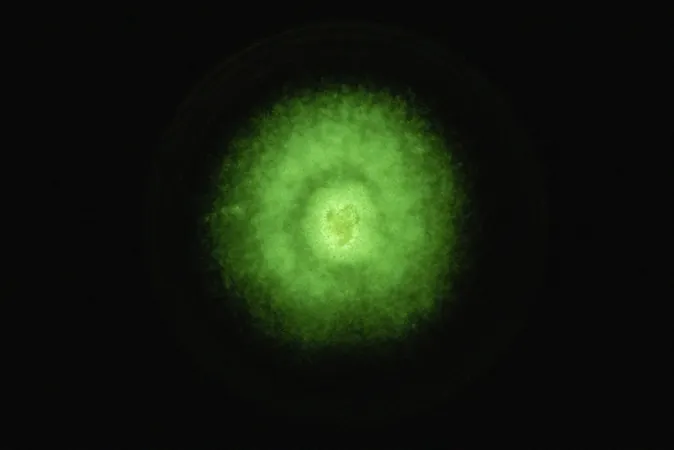
Glow in the Dark: Swiss Artists Unveil a New Bioluminescent Mushroom!
2025-01-07
Author: Yu
Introduction
In a groundbreaking discovery that challenges our understanding of fungi, Zurich-based artists Heidy Baggenstos and Andreas Rudolf have unveiled a stunning new species of glowing mushroom right in the heart of Switzerland. While many may equate bioluminescence with tropical rainforests, this revelation sheds light on the hidden wonders of Swiss forests.
The Journey of Discovery
For over a decade, Baggenstos and Rudolf have immersed themselves in the mysterious world of bioluminescent organisms. Their mission? To prove that the enchanting glow of these mushrooms is not restricted to faraway lands, but is also a part of local biodiversity. “We want to show that these bioluminescent mushrooms are present in Swiss forests and that we do not have to travel far to find them,” states Baggenstos passionately.
The Magical Encounter
One fateful evening while exploring the Albisrieden neighborhood's dense woods, the duo stumbled upon an ethereal green light captured by their camera. Interestingly, the mushroom's luminescence is often so faint that it goes unnoticed by the naked eye. Rudolf explains, "Today, we always have mobile phones or flashlights, but to appreciate bioluminescence, the surrounding environment must be pitch black."
Identification of the Species
Initially, the pair believed they had discovered *Mycena haematopus*, a known glowing species. However, upon further investigation back in their studio, they realized they had stumbled upon *Mycena crocata*, also known as the saffron drop bonnet mushroom. This particular specimen is distinguished by its saffron-colored fluid and has yet to be documented for its bioluminescent properties.
Collaboration with Mycologists
Teaming up with mycologist Renate Heinzelmann from the Swiss Federal Institute for Forest, Snow, and Landscape Research (WSL), the artists were able to characterize and document their new find in an article published in *Mycoscience*. Using long-exposure photography and a specialized luminometer, they meticulously documented the light emission from various parts of the mushroom. Heinzelmann acknowledged the artists' unique contribution, stating, "Most of the experiments were conducted by the artists. They collected the samples, took the photographs, and made the light measurements."
Understanding Bioluminescence
The phenomenon of bioluminescence results from a chemical process where living organisms like fungi produce light through a series of reactions. Unlike fluorescence, which relies on an external light source, bioluminescence occurs entirely from within the organism. Interestingly, the research revealed that while most of the fruiting body of *M. crocata* emits little to no light, its mycelium—the underground network vital to the mushroom's survival—shows the most incredible luminescence. Remarkably, the decaying wood where *M. crocata* thrives also glows green when exposed, creating a mystical ambiance that can last for hours.
Future Prospects
With promising genetic studies confirming the presence of bioluminescence-related genes in this new species, Heinzelmann is optimistic about future discoveries. She states, "There will constantly be more bioluminescent species discovered—bioluminescence is under-researched, and the more people look, the more they will find."
Historical Context
The allure of glowing fungi has fascinated humanity for centuries, dating back to Aristotle's observations over 2,000 years ago, when he described them as a “cold fire” emerging from rotting wood. Despite advances in understanding the biological mechanisms behind this phenomenon, the ecological purpose of bioluminescence remains a tantalizing enigma.
Mysteries Yet to Unravel
Could it be a strategy to lure insects for spore dispersal, or does it serve another, yet undiscovered role? Heinzelmann states, "Bioluminescence has been maintained for a long time, so we assume it has some function, but it’s still a mystery."
Conclusion
This astonishing discovery not only highlights the biodiversity hidden within Swiss forests but also underscores the importance of interdisciplinary collaboration between art and science. Who knows what other luminous revelations await us in the depths of nature? Stay tuned!
 Brasil (PT)
Brasil (PT)
 Canada (EN)
Canada (EN)
 Chile (ES)
Chile (ES)
 Česko (CS)
Česko (CS)
 대한민국 (KO)
대한민국 (KO)
 España (ES)
España (ES)
 France (FR)
France (FR)
 Hong Kong (EN)
Hong Kong (EN)
 Italia (IT)
Italia (IT)
 日本 (JA)
日本 (JA)
 Magyarország (HU)
Magyarország (HU)
 Norge (NO)
Norge (NO)
 Polska (PL)
Polska (PL)
 Schweiz (DE)
Schweiz (DE)
 Singapore (EN)
Singapore (EN)
 Sverige (SV)
Sverige (SV)
 Suomi (FI)
Suomi (FI)
 Türkiye (TR)
Türkiye (TR)
 الإمارات العربية المتحدة (AR)
الإمارات العربية المتحدة (AR)